From the esoteric point of view, Consciousness (Light) is the relationship between Spirit (Energy) and Substance (Matter), E = mc² in Einstein’s formula.
Analogically, it can be said that the Evolution of Consciousness tends to the ever more perfect symmetry between Spirit and Substance, to Their golden proportion: to the Beauty of Being.

Between philosophy and science, here are some excerpts from a beautiful paper in Italian (found on academia.edu) on the concept of symmetry between One and Many, between Unity and Differentiation (footnotes, links and images are by TPS):
Symmetry and knowledge
… In Plato, the distance from the One as a result of the Dyad remains hidden in perceived things, as a distance from the “model” of which things are images. Imperfect symmetry, but still symmetry, is what remains in things as a reminder of the One. What can unite two different ones? It is the sun-metry, that is, the co-measurability.
In the Timaeus the term “sun-metry” appears, but it is not the equivalent of the English “symmetry”; it is rather the term “analoghía” which should be translated as “symmetry”. Analoghía however means proportion. In proportion, whether it is arithmetic, geometric or harmonic, a proportional mean unites two quantities. It identifies what remains unchanged when one passes from two quantities in relation to each other, to other two.

In Timaeus, 31 C Plato writes that the most beautiful of bonds is the one that of many things makes one. And this by its very nature fulfils the analoghía in the most beautiful way.
Beauty is involved, understood as agreement among the parties, similarity, equality of relationships, harmony with a rational principle! Between proportion, symmetry and beauty there is a hermeneutic circle, dominated by the unifying role of analoghía.
The text quoted in its entirety says: “But two things alone cannot be satisfactorily united without a third; for there must be some bond between them drawing them together. And of all bonds the best is that which makes itself and the terms it connects a unity in the fullest sense; and it is of the nature of a continued geometrical proportion (analoghía) to effect this most perfectly. For whenever, of three numbers, the middle one between any two that are cubes or squares is such that, as the first is to it, so it is to the last, and conversely as the last is to the middle, so is the middle to the first, then since the middle becomes first and last, and again the last and first become middle, in that way all will necessarily come to play the same part towards one another, and by so doing they will all make a unity”. (Timaeus 31 C, 32 A.)
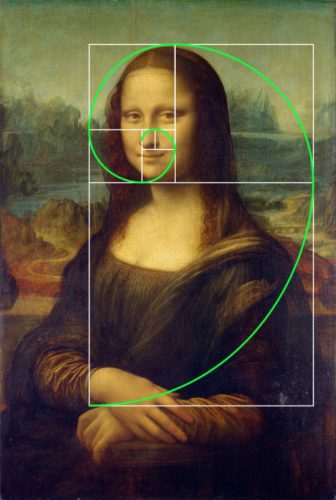
In every search for symmetry, for the ancients and for the moderns, the same concern is implicit: to find what makes a set of elements the parts of a whole, connected to each other by mathematical relationships.
… An absolute symmetry would be the domain of the identical, of what is not perceivable. Everything we perceive can be discerned because an absolute symmetry has been broken, otherwise nothing definite or different would exist. The initial symmetry remains hidden in the multiplicity of different ways in which symmetry can be broken.
… Why does the discovery of a symmetry cause pleasure? [1] Plato, taken up by Kepler, tells us that this depends on a process of recognising and remembering the world of ideas, which is favoured by the dianoetic role of geometry.
Plato’s idea was taken up by Jung and Pauli with the theory of archetypes. In his commentary on Kepler’s work, Pauli writes: “The process of understanding nature, as well as the intense happiness that the human being feels in understanding, that is, in becoming aware of a new truth, seems to be based on a correspondence, on the concordance between pre-existing internal images [archetypes] in the human psyche and objects of the external world with their properties. This theory of knowledge famously dates back to Plato and is supported with great clarity by Kepler himself”. [2]
The Hellenic tradition and the search for the principle
In the history of Western thought on the “nature of things” two traditions have faced one another: the atomistic one, dating back to Leucippus and Democritus, and the one that sees the identical that persists in transformations, not in material particles, but in the formal structure. This tradition, originating from the school of Pythagoras, through Plato’s Timaeus, reached Galileo and Kepler in the seventeenth century.
Today the theory of symmetry groups seems to bring these two traditions together, since the algebraic structure of a group of transformations plays the formal role of unifying the fundamental particles and their interactions.
Regarding the Pythagorean school [Aristotle] states: “They first applied themselves to mathematics and made it progress, and, nourished by that, they believed that its principles were principles of all beings. And […] they thought that the elements of numbers were elements of all things, and that the whole cycle was harmony and number. And all the concordances that they could show between numbers and musical chords and phenomena and parts of the cycle and the entire ordering of the universe, they collected and arranged”.
… From the Pythagorean intuition onwards, a few questions arise, the nature of number, the relationship between geometric shapes, number and cosmos, and the “mind of God”.
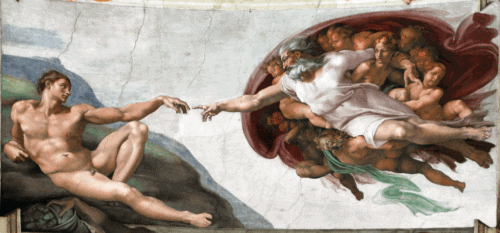
It is known that the Pythagorean school considered the problems related to musical scales with the utmost attention. Ferguson has been following the history of the relationship between music, physics and astronomy from the 6th century BC up to the physics of the twentieth century. The correspondence between numerical ratios and musical chords, starting with the fifth chord, which will play a fundamental role in Kepler’s world system, inspired them the idea that behind things there were hidden regularities expressible through ratios between integers: “In the universe there was order, and this order was made up of numbers. […] Pythagoras and his followers had also discovered that there was evidently a powerful link between the perceptions of human senses and the numbers that pervaded and governed everything. Nature followed a fundamental, rational, beautiful logic, and human beings were in agreement with it, not only at an intellectual level (they could discover and understand it) but also at that of the senses (they could perceive it through hearing in music)”.
… Not enough thought has yet been given to how much musical theories and the concept of harmony influenced the birth of modern science in the seventeenth century: “Many science historians, including Drake, have underlined the gap that arises from neglecting music as the fundamental component that linked together works of astronomy, acoustics, optics and physiology. In fact, in those years, scientists such as Kepler, Mersenne, Galileo, Descartes, Huygens, Newton, and later Euler, were deeply involved in the discussions related to the problems that were classified as musical, but which intertwined with those researches that we today see more directly related to the development of modern science. […] Music theory thus became the meeting point between the abstract world of numbers and physical reality”.
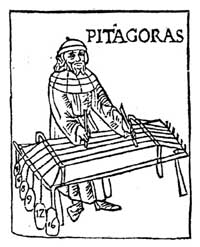
The story begins with the school of Pythagoras and with the problem of identifying a mean ratio between two terms: arithmetic, geometric, harmonic.
The different proportions were then heard through the monochord. It was a question of dividing a string into two parts with a little bridge and deciding which ratios between the parts corresponded to a pleasant sound.
… Plato himself, in the Republic (Politeía) 336 D, pointed out the need for mathematics as a training for the mind that searches for forms; it is said that on the door of his Academy he had the following words engraved: “Let no one ignorant of geometry enter”. Regarding geometry, Plato writes: “Geometry is actually the knowledge of what eternally is”.
When Plato returned to Athens, after visiting the Pythagorean scholar Archytas in Taranto in 389 BC, he adopted a Pythagorean study programme for his Academy: arithmetic, geometry, astronomy, music.
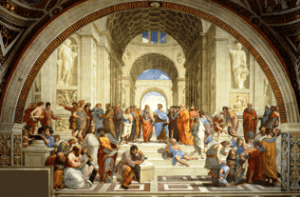
In Book VII of the Republic, where the famous image of the cave is found, the dianoetic ascent from doxa (opinion) towards episteme (knowledge) and from eicasia (imagination) towards noesis (intellection) and the subsequent descent to the government of the state are described as a training that requires the science of number (524 D, 526 C), plane geometry (526 C, 527 C), astronomy (527 D, 529 C), the science of harmony (529 C, 531 C). The music we are talking about is not the practice of “crumpling the strings”, but the science of numerical relationships. The science of the harmonics is inextricably linked in the quadrivium to the other three disciplines. In Plato’s perspective, however, they must all be cultivated “in the abstract”. For example, astronomy must be studied through problems and not just “looking up” (529 C).

… In the Timaeus Plato explains his cosmology and hands over to the subsequent tradition the idea that everything is governed by symmetry, relationships and proportions. … This refers to the origin of the universe (sky, planets, man, animals) and its constitution. Matter, a dark and indeterminate reality, “the receptacle of all that is generated – its wet nurse, as it were” (49A and 51A), waits to be informed by a principle. The Demiurge convinces blind necessity, as opposed to intelligence, and which operates as a wandering cause (πλανομενη αιτια, 48A), to lead generated things towards the best. And the best is the imprint of the one in the manifold, carried out by mathematics, an intermediate form between the One and the multiple. [3]
At the beginning chaos reigned, “as it happens when God is absent; He then modeled (διεσκηματισατο) these things that were in this state with shapes and numbers (ειδεσι τε κατ αριτμοισ) – 53, B”. Air, water, earth and fire are changing realities and cannot be principles. Principles are the scalene right-angled triangle, half of the equilateral – from which the tetrahedron (fire), the octahedron (air) and the icosahedron (water) can be composed – and the isosceles right-angled triangle, from which the square and the cube (earth) can be formed. The dodecahedron cannot be made of triangles and represents the cosmos. Earth cannot thus turn into air, water and fire, because it is made up of different geometric atoms. The elements are held together by proportion. Concrete things are not air, water, fire, earth but a mixture of them. So we cannot say “this is fire”, but “such is fire”. This, we might say, is the “standard model” according to Plato!
Euclid after Plato will formalise the theory of proportions in book V of his Elements …
In the Timaeus all the different parts are held together through proportions. The soul of the world, composed of the synthesis of the Identical and the Different, is structured in parts, according to numbers 1, 2, 3, 4, 8, 9, 27. This structuring makes it possible to recognise proportions in the outer world. A further substructure connects the parts through proportions that reproduce the chords of the Pythagorean scale, the smallest of which corresponds to successive divisions up to 256/243, that is the semitone of the scale. The scale to which Plato refers is the diatonic one introduced by the Pythagorean Philolaus.
Kepler: the way of proportions and the unity of the cosmos

When we talk about the role of symmetry in Kepler’s astronomy, we immediately think of the five regular polyhedra. As a matter of fact the role of Platonic solids is in Kepler gradually more and more marginal, allusive and symbolic, limited to determining the number of planets, while other symmetries, based on harmonic chords, will increasingly acquire the role of supporting structure of the cosmos. His use of symmetries, with due caution and distinctions, has surprising similarities with the way they’re used in particle physics. At the end of his work Kepler will think he has found through a formal structure the way to keep together the number of planets, the distances of the planets from the sun and their variations, orbital periods, density and masses of the planets, dimensions of the cosmos … and then theology, soul and form of government.
… The tradition of the five Platonic solids had found a careful dissertation in the XIII book of Euclid’s Elements, which will be a source of inspiration for Kepler. In 1509 Luca Pacioli (De Divina Proportione) testified to the interest of the Renaissance in Platonic solids. Leonardo will illustrate Pacioli’s work by drawing them transparent and thus highlighting their structure. Leonardo’s innovation will be taken up by Kepler in his Mysterium.

In the Dissertatio cum nuncio sidereo, published in 1610, immediately after reading Galileo’s Nuncius, Kepler explains the reasons for his attention to geometry and regular polyhedra: “Geometry is one and eternal, shining in the mind of God, and the involvement of men in it is one of the causes for which man is the image of God. Well, in geometry, after the sphere, there is a family of figures which is the most perfect of all, that of the five Euclidean solids. This planetary world of ours is arranged precisely according to the rule and model of these solids”.
… The only ones who welcomed Kepler’s work were Galilei, then an unknown mathematician from Padua, and T. Brahe.
… The originality of Kepler’s astronomy, for which we can consider him the first astrophysicist, consists of some questions that other astronomers did not ask, considering them senseless or unanswerable: Why are there exactly a given number of planets? Why are they at a certain distance and why do they move with a certain speed? What are they driven by?
A. Koyré writes: “Kepler seeks answers where no one else sees problems”. For Copernicus it is still the celestial spheres that carry the planets around, for Bruno it is the animae, Brahe takes refuge in a purely calculating attitude. According to Koyré, the question, with such a purely physical flavour, has a theological root. Kepler considers as unity the sun, the fixed stars and, most importantly, the space in between. The Sun is the driving cause, space is the field in which these forces propagate. The theological idea is to consider the three as an icon of the Trinity: the Sun, symbol of the Father, the Stars, symbol of the Son, the intermediate Space, the place of creation, symbol of the Spirit.
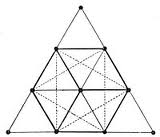
… In space the solids of the Timaeus provide the way to determine, in a non-arbitrary way, the number of planets. So this number is obtained as a result of the cosmos being created following certain symmetries.
… It is not understandable Kepler’s exultation for having found precisely in the ratio of the harmonic fifth (3:2) the law that links distances and times of revolution, if one does not follow that long tradition of researchers (Pythagoreans, Ptolemy, Boethius, John Scotus Eriugena, Copernicus, etc.) who had continued for centuries to carefully examine the motion of the planets (distances and speeds) to find harmonic relationships. The harmonic relations were the invariants that connected the cosmos in the passage from one planet to another. The search for such harmony was dictated by the idea that there should be a profound relationship between the perceived harmonic chord (soul) and the numerical relationships concerning the planets (cosmos), between musica humana (human music) and musica mundana (music of the spheres).

For Galileo, elliptical orbits break the symmetry of the cosmos. For Kepler they lead the way towards the discovery of deeper symmetries, consisting of ratios and proportions all generated by the ratio of harmonic fifth … [But even] when Kepler renounces circular orbits, the archetype of the circle and the sphere remain fundamental. After all, Kepler’s cosmos remains spherical. God, soul and cosmos are understandable through a single archetype. When the rays of the planets coming from suitable angles are perceived, they are consonant and resonate within the soul. The appropriate angles are those relative to the regular polygons inscribed in the circle; the positioning of the planets so as to be observed under such angles constitutes an “aspect”. The harmonious chords of the Pythagorean scale derive from the ratios that can be combined with the sides of these polygons (for example the fifth, 3/2, with the pentagon [or with the Triangle and the 3rd Ray? – ed]).

… The Platonic project of reducing the many to one does not lead him towards atomism. From Mysterium (Mysterium Cosmographicum, The Cosmographic Mystery) to Harmonices (Harmonices Mundi, The Harmonies of the World) the common thread towards unity, which will lead Kepler to the discovery of the three laws and to accomplish “the defeat of circularity”, is the search for the physical explanation of the world, of its harmonic structure.
Even when Kepler sought, in Strena seu de nive sexangula (1611), the cause of the six-cornered symmetry of snow, he did not go towards the atomic structure but towards formal reasons of surface-volume efficiency. They are formal motives that make man and the world resonate in the same way [we would replace formal motives with functional ones, in the sense that form is determined by its function in relation to the whole, which in turn depends on the underlying principle/archetype – ed]. The proportion in the distances and in the speeds of the planets is such as to be recognised by the human mind which carries within itself such proportions as archetypes.

Elliptical orbits are the result of physical necessity and of the laws of harmony.
In order to build the world according to the laws of harmony, regular solids are not enough, which would give concentric circular orbits and constant velocities; the harmonic proportions force the Creator to vary the speeds of the planets. … In short: astronomical data (1) + harmony (2) + physical necessity (3) = elliptical orbits. The Platonic solids, after the observations made by Tycho Brahe, have only the task of establishing the number of planets [up to Saturn – ed].
… To build cosmic harmony Kepler starts from Saturn, for which we have a major third interval between aphelion and perihelion. Starting from a tone G [4], the chord will be G-B. To build the melodies of the other planets, it is necessary to divide the angular velocities by two [octave reduction for the string length, octave elevation for the frequency – ed.], until you get tones on the same octave of Saturn. For example, if we divide five times the angular velocity of the Earth at the aphelion by two, we get 1’47” which is close to the speed of Saturn at the aphelion. The melody of the Earth will then also begin with a G, five octaves above that of Saturn.
… The agreement between the planets must be built starting from the G of the Earth and the E-Eb of Venus [a third]. Elliptical orbits and variable speeds reveal deeper and more hidden symmetries that connect astronomy and music; they are dynamic symmetries with respect to the static ones associated to the geometric shape.
The fact remains that the relationship between the time of revolution and the distance is yet unknown. If we knew it, we could find the distances, starting from the times, that is, from harmony. Kepler searched for this relationship for more than two decades; it cost him 17 years of attempts on Brahe’s data and it finally became clear to him on May 15, 1618: “It is very certain and very exact that the periodic times of two any planets are precisely in sesquialter proportions of their average distances, that is, of their orbs”. That is T1² / T2² = R1³ / R2³ (Called T1 and T2 the periods necessary for two planets to complete their orbits and R1 and R2 the respective average distances between the planets and the Sun, the ratio between the squares of the orbital periods is equal to the ratio between the cubes of the average distances from the sun).
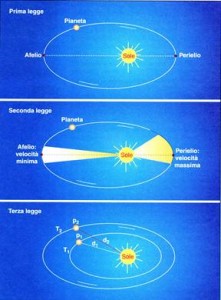
At this point Kepler, starting from the orbital periods and setting the average distance between Earth and Sun equal to 1000, obtains for each planet the semi-major axis and the eccentricity and compares them with Brahe’s data. “The harmonic theory emerges victorious from the comparison with the facts”.
The long journey, which lasted twenty-four years and led him from the materiality of form to harmony, from Mysterium to Harmonices, is described by Kepler in the fifth book of the latter: “The proportion that regular solids would have prescribed to planetary orbs, as inferior and relative only to body and matter, had to yield before the harmonies, inasmuch as they could approximate and contribute to the beauty of the motions of the globes”.
Harmonices is the sequel to Mysterium, the apogee of an obsession that lasted a lifetime. Here Kepler was simply trying to reveal the fundamental secret of the universe by offering a vast synthesis of geometry, music, astrology, astronomy and epistemology. It was something that no one had attempted since Plato’s time and no one has ever tried again [actually Hans Kayser has done it! – ed]. After Kepler there’s been again the fragmentation of experience, with science separating from religion, religion from art, substance from form, matter from spirit.

… Particle physicists have taken up the dream of a unification, in which theories have fewer unjustified constants. In the history of understanding strong interactions, one almost gets the impression that physicists at some point were concerned with building simple and elegant theories following the thread of symmetry and that they studied them even when they were clearly in contrast with the experimental data, animated by the confidence that the number and masses of particles should respond to a logic in which beauty had to play a role. Yang and Mills’ theory was good, but its predictions seemed to contradict the fact that the bosons of the weak interaction must have mass. A symmetry breaking mechanism had to be invented. A karstic river flowed under a purely phenomenological approach waiting to be able to re-emerge. When it did it had all the connotations of Kepler’s programme: explaining the variegated world of fundamental interactions with unifying structures.
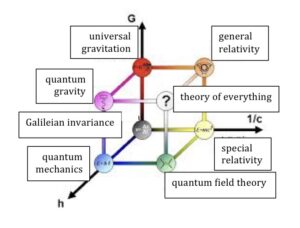
From the Ionian philosophers until today, the idea that nature is understandable, that it is a book, that the complication of becoming and of the levels of reality responds to simple and elegant bonds at a fundamental level has never abandoned research.
… The history of the standard model [5] is the conclusion of a long journey, which began in the twentieth century with Einstein, Heisenberg, Noether, Weyl, Yang and Mills: “With the understanding of the spontaneous symmetry breaking, the various contributions eventually came together in the “standard theory”. This marked the return of those who believed in the beauty and perfection of the fundamental laws of physics”. It was also perhaps Kepler’s payback.
This comeback has re-proposed in a more pressing way a problem that has a long tradition behind it: that of the role of mathematics in the understanding of nature and in physics in particular. The algebraically formalised law of nature is the object that holds together disparate phenomena in a given area. Symmetry is the constraint the law undergoes or must comply with if symmetry is used as a heuristic ‘a priori’. Symmetry is defined by the group of transformations which the equation that formalises the law can undergo, so that it remains covariant.
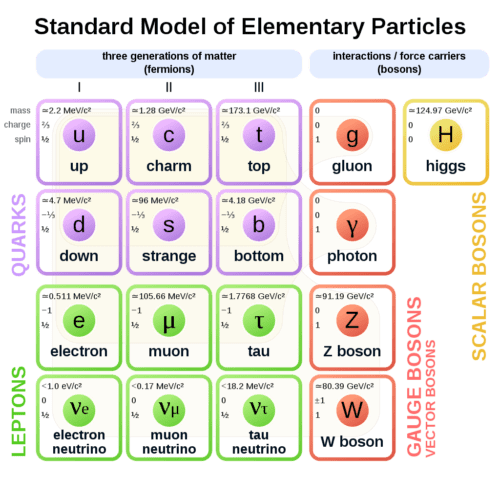
But what is the philosophical meaning of all this? Wigner’s problem: “What is the reason for the effectiveness of mathematics in physics?” is, as we have seen, very old and has been turned over and over countless times.
… If we stay focussed on the seventeenth century we can say that Galileo, Kepler, Descartes, Boyle, Newton had different ideas on the role of symmetry in the laws of nature. But everyone of them confronted the problem, explicitly or implicitly. Everyone, in different ways, shared the Christian idea [more generally, of all spiritual traditions – ed] that a world created by the Logos could only be intelligible.
Modern particle physics has sharpened the problem of the effectiveness of mathematics in physics, since it assumes the requirement of symmetry as a winning heuristic and methodological a priori! From 1905 onwards, a scientific law can only be accepted if it is invariant with respect to a particular group of transformations. Indeed the supreme law seems to be: every physical law must be covariant.


But what is the valence in realism of hidden symmetries, given that they are not empirically accessible, and only the phenomena resulting from the breaking of the hidden symmetry are? Where does the asymmetry of the states come from if the structure is symmetrical?
… We can add another question to the ones already formulated: Can a single physical theory take into account all phenomena? There are two marked aspirations in collective feeling: the aspiration to a unitary image of the world and another one that, conversely, leads to mark the diversity, or even the differences. [6]
Is the book of nature really a book? Boyle, in “The virtuous Christian”, is sure: “The book of nature is a large and beautiful rolled tapestry that we cannot see all at once, but we must be content with waiting for the discovery of its beauty and its symmetry little by little”. Just like Galileo, Kepler, Newton!
… Getting back to Wigner’s considerations, we would then be faced with problems and mysteries; the latter seem to be difficult to manage by any philosophical theory. But we are faced with problems and mysteries which, instead of inducing impoverishment or frustration, paradoxically lead back to the meaning of life and research. … “The full meaning of life, the collective meaning of all human desires, is fundamentally a mystery beyond our comprehension. As a young man I was irritated by this state of affairs. But now I’ve made peace with it. I also feel a certain honour to be associated with such a mystery”.
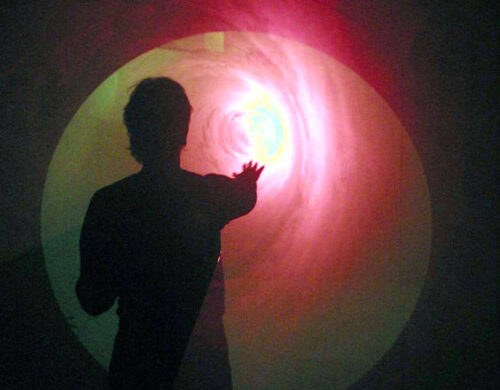
Beginning and end are mirrored in each other, therefore they coincide.
The rhythm that unites them lives in Space,
where everything that is duplicated comes together.
A Law secretly presides over freedom without preventing it:
it is the Law of proportional symmetry, which governs
what goes from the Highest to the Abyssal and balances them.
*
I am at the Centre and I am the Centre everywhere.
I set the points of departure and arrival.
Thus I produce Beauty, which is the sign of union.
(Ritual of Capricorn, 4th aspect)
This article comes out in correspondence with the important Earth-Venus-Sun alignment, one of the 5 that draw in the Heavens, every 8 years, the 5-pointed Star of their mutual Relationship – see Signs of Heaven year 2021 – Second Quarter.
[1] Perfect symmetry, though, also causes discomfort. It is always necessary that an element of rupture, even an hidden one, makes the symmetry closer to life. It is reported by many authors and in different variants the idea that the introduction of asymmetrical elements in tapestries or mosaics was done on purpose so as not to provoke the wrath of the gods. Thomas Mann, in a famous passage of The Magic Mountain, makes the protagonist, lost in a snowstorm, perceive something deadly in the “icy regularity”, “hostile to life”, of each snowflake, alongside the joy that nature feels when creating, since each snowflake was different from another.
[2] Pauli, at the end of his work on Kepler, observed (in 1952) that scientists had lost the unitary image of the world and wondered if it was possible to retrieve it. The condition for the recovery, however, was that the natural sciences should accept their being only a part of this image.
[3] Dijksterhuis comments: “The whole spirit of the Timaeus is diametrically opposed to that of the image of the world of the Atomists. While in the opinion of these both the genesis of the universe and the events that take place in it remained subject to blind chance, in the Timaeus a benevolent and wise Demiurge transforms chaos into an ordered cosmos; while the Atomists considered the life of gods and men as a special case of the universal mobility of atoms, Plato makes the world a living being by providing the world body with a world soul; while the Atomists had no answer to give to the problems of the existence of the universe and its purpose, the Timaeus explains both: the goodness of the Demiurge could not allow chaos, and induced Him to transform the chaotic spatial matter in a harmonious and balanced whole, which had to be as similar as possible to Him”.
[4] Considered at the time as the starting note of the musical scales and marked with the letter γ (gamma), which also indicated the crossing point between the ecliptic and the celestial equator, origin of the reference system for calculating the position of the stars in the sky.
[5] “The Standard Model contemplates a certain number of arbitrary parameters (about twenty), and as far as we know nowadays, the theory would be mathematically consistent with any value of these parameters, at least within rather wide limits. Some of these parameters continuously determine how the symmetries of the Standard Model are broken. Each of these realisations would give life to different Universes, equally consistent, with a wide range of physical properties and with different modes of evolution” (Maiani in Battimelli, p. 57).
[6] “It is, again, Plato and Aristotle facing each other. On the one hand, the aspiration to bring everything back to a common matrix: the One. On the other hand, the defense of the autonomy of beings, of their irreducible diversity, of their non-deductibility from a basis of reduction. Reductionism and anti-reductionism, attention to the parts and the whole, atomism and identification of the substance, understood in the Aristotelian sense, as an entity to which to attribute existence in the proper sense, are both tendencies that we find among physicists, even if a reductionist philosophy prevails”.






What a great job you have done to bring all of these extensions to the ONE as they out picture in the material infinitude. Such beauty profound, as all true seekers are driven by the subjective force of the hidden will to BE. All search for the hidden Singularity, and to describe it by their vocabulary, as it underlies every potentiality to describe (limit it by time/space) IT.. From the induction to the deduction, all must have a common genesis, but when that is objectified (as the human mind must do), then only the durative derivative, the fractal of it is seen in “measure”,…. so as science, and philosophy must so work as inward or outward, they still process by this extension of the apriori “point”, of which they search in its “remainder”. All derive (the infinity of the objective) from the pre causal purpose…..Such purpose. as the “Mind of God” can pretend to become, will become by this when transcended by the “form” of its identification .This identification can be known. This is the Great Singularity, of which the Chiron paradigm “Chiron and Group Fusion” shows in the subjective “point” of this becoming. This is the alpha/omega state as pre quantum, which by correspondence in thought can God so “duplicate”. This “duplicate” can be known in higher thought with the purpose of its Being .At this “point” of sacrifice (renunciation), and the limits of the container of identification, the separate self is given “away” (to God(the Whole)), so the reciprocal can “join” as Higher Self. This is a pre physical, and potential (electrical) relationship of the Cosmic Magnet…This is the hidden driver of truth in the heart as it :”effects” intelligence and by so doing is Will so born as to “Become” the synthesis of what it IS. It is a hologram which “contains” itself in Itself., and by this is every part infinite in itself…This is how man becomes God, the basic hidden design of initiation which must be hidden in test of the will which is the measure of God to its Becoming, which is pure Being (beyond time and space, measure and form)…It can be “contained” by Gods own laws, as primary in process, by attraction. economy and synthesis….This “design” is both cause and effect as one, as the singularity. When the mind so “beholds” this pattern (as shown in the Chiron paradigm), this recognition must attract and be the inner point of the beginning of the form….So by thought as the Higher Mind in abstraction (by love/intelligence so known by experience toward perfection, as the soul and the hidden monad become), so the will will Will…The Great Singularity must in itself so bridge the causative and effective. This must remain hidden until this is done, as this doing can only BE in the ONE….When this is known, then the fusion will God so BE Identified…This “design” of the paradigm is formless into form, as time and space are shown and known by It…Only by the inner “point”, can the outer “points”.so become and Be. Every identification must come by this….every expression of the infinitude has the beauty latent it its potentiality to become…So BE the Chiron paradigm…It Is a fusion engine to this infinity to Become, and an “initiation” temple, which will accelerate itself as God so IS…..It is behind all Great ONE’s, as they express the infinitude of God…By It is separation not.